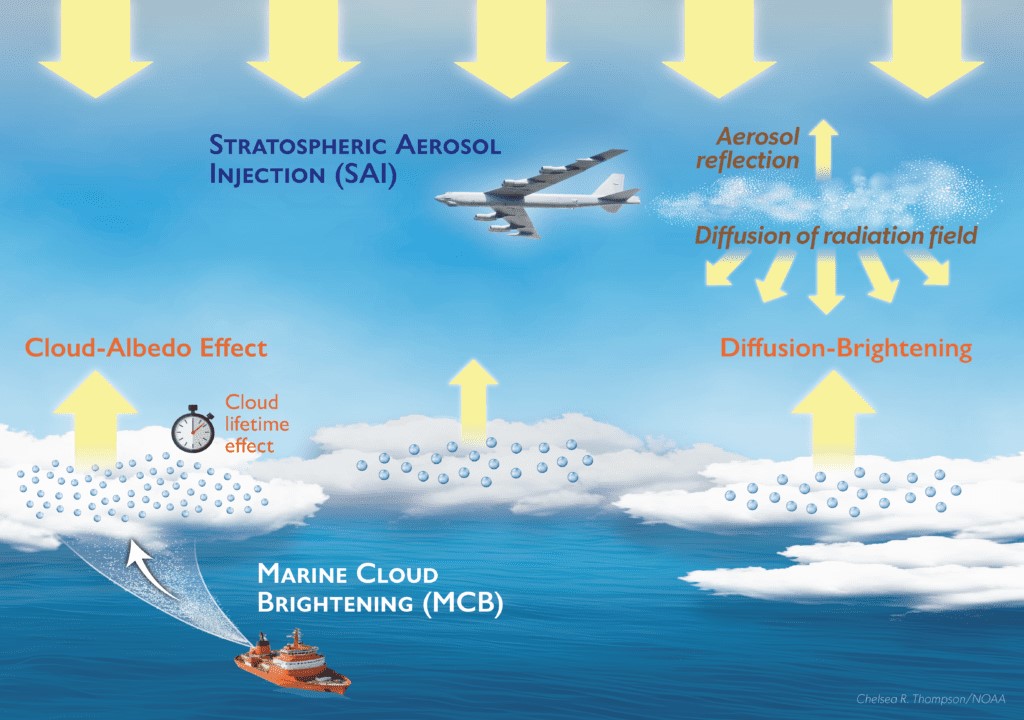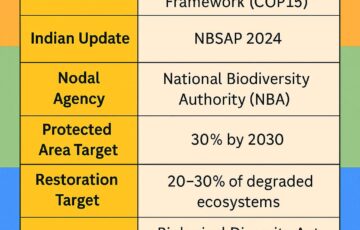Stratospheric Aerosol Injection: Feasibility, Risks, and Innovation in Climate Engineering
Stratospheric Aerosol Injection: Feasibility, Risks, and Innovation in Climate Engineering
Why in the News?
A new study in Earth’s Future explores using existing aircraft for low-altitude stratospheric aerosol injection (SAI) to cool the planet and mitigate global warming. This cost-effective method of solar radiation management, which contributes to global dimming, could fast-track climate intervention efforts but raises environmental and geopolitical concerns due to its global impact on regional climate effects. As the world grapples with the challenges of global warming, innovative approaches like SAI, which draw inspiration from the cooling effects of volcanic eruptions, are gaining attention in the scientific community.
New Study’s Approach and Findings
- Researchers explored low-altitude injections (~13 km) using modified commercial jets like Boeing 777F for SAI deployment, advancing aerosol dispersal methods.
- Simulations using climate models showed that injecting 12 million tonnes of sulfate aerosols annually in spring/summer could cool Earth by 0.6°C, affecting the global mean temperature. This approach is part of broader global cooling techniques being investigated to combat global warming.
- Higher cooling (1°C) requires 21 million tonnes/year of sulfate aerosols; only 7.6 million tonnes needed if sprayed from higher altitudes in subtropics, demonstrating the impact of internal climate variability on SAI effectiveness.
- Lower-altitude SAI is cheaper and technically feasible sooner, as developing high-altitude aircraft for climate intervention strategies could take a decade. The study considers how internal climate variability might affect the outcomes of SAI implementation.
Risks, Concerns, and Ethical Debates
- Environmental impacts of SAI include stratospheric ozone depletion, acid rain, regional climate imbalance, and potential to trigger geopolitical tensions. There are also concerns about stratospheric warming and its effects on atmospheric dynamics.
- Cooling polar regions more than tropics may worsen climate inequality and alter regional temperature changes, potentially affecting vapor pressure deficit in different areas.
- Could reduce urgency for greenhouse gas emission cuts by masking warming, potentially leading to a perceived failure in addressing the root causes of climate change. This perceived failure could undermine long-term geoengineering efforts and public trust in climate interventions.
- Scholars debate its governability and fairness, with calls for international governance of geoengineering and even a moratorium on climate engineering R&D, highlighting the need for careful policy decisions regarding SAI deployment.
What is SAI and How It Works? |
|
● Stratospheric Aerosol Injection (SAI), a form of solar radiation modification, involves spraying reflective particles like sulfate aerosols into the stratosphere (~20 km) to reduce sunlight and cool Earth, addressing global warming. |
|
● Inspired by volcanic eruptions, such as Mount Pinatubo (1991), which cooled the Earth by emitting aerosols and increasing atmospheric albedo modification. The cooling effect of volcanic eruptions has been a key model for SAI development, as these natural events demonstrate the potential impact of aerosols on global temperatures. |
|
● Higher altitude injections are more effective as particles linger longer, avoiding washout by rain and influencing the Brewer-Dobson circulation. |
|
● Effectiveness depends on material type, injection timing, and altitude/location, factors crucial for successful climate intervention and achieving temperature targets. |
This innovative approach to climate change mitigation through stratospheric aerosol injection presents a complex interplay of potential benefits and risks. While it offers a possible solution to combat global warming, the environmental impacts of SAI and its effects on regional climate patterns require careful consideration. The study’s findings underscore the need for comprehensive climate modeling for geoengineering and thorough analysis of atmospheric chemistry changes before any large-scale SAI deployment.
As the global community grapples with the challenges of climate change, the exploration of climate intervention strategies like SAI raises important questions about our approach to environmental stewardship. The potential for SAI to influence radiative forcing and alter precipitation changes highlights the far-reaching consequences of such interventions. Moreover, the possibility of affecting drought patterns and extreme weather events adds another layer of complexity to the decision-making process.
The ethical concerns of geoengineering loom large in this debate. The potential for SAI to mask the symptoms of climate change without addressing the root cause – greenhouse gas emissions – could lead to a perceived failure in long-term climate goals. This perceived failure underscores the importance of viewing SAI as a complement to, rather than a replacement for, robust emission reduction strategies.
Furthermore, the international implications of SAI deployment cannot be overstated. The potential for unilateral action by nations or entities to alter the global climate raises significant questions about international governance of geoengineering. The need for a coordinated global approach to regulate and oversee such climate intervention efforts is paramount to ensure equitable outcomes and prevent potential conflicts arising from uneven regional climate impacts.
As research in this field progresses, it is crucial to maintain a balanced perspective, weighing the potential benefits of SAI against its risks and uncertainties. Continued study of internal climate variability, aerosol optical depth, and the complex interactions within Earth’s climate system will be essential in refining our understanding and approach to climate engineering techniques like SAI. Researchers must also consider the potential for tropospheric cooling as a result of SAI and its implications for weather patterns and ecosystems.
In conclusion, while stratospheric aerosol injection presents a potentially powerful tool in the fight against global warming, its implementation must be approached with caution, thorough scientific scrutiny, and robust international cooperation. The path forward requires careful navigation of scientific, ethical, and geopolitical considerations to ensure that any climate intervention strategies serve the global community’s best interests while safeguarding our planet’s delicate ecological balance. It is also crucial to consider the potential impact on biogeophysical tipping points, as SAI could have unforeseen consequences on critical Earth systems. The perceived failure or success of SAI deployment will likely shape future geoengineering efforts and global climate policy for generations to come, making it essential to address any potential perceived failures proactively and transparently. As we continue to explore the possibilities of SAI, we must remain mindful of the lessons learned from studying volcanic eruptions and their global cooling effects, ensuring that our approach to climate engineering is grounded in robust scientific understanding and responsible governance.






